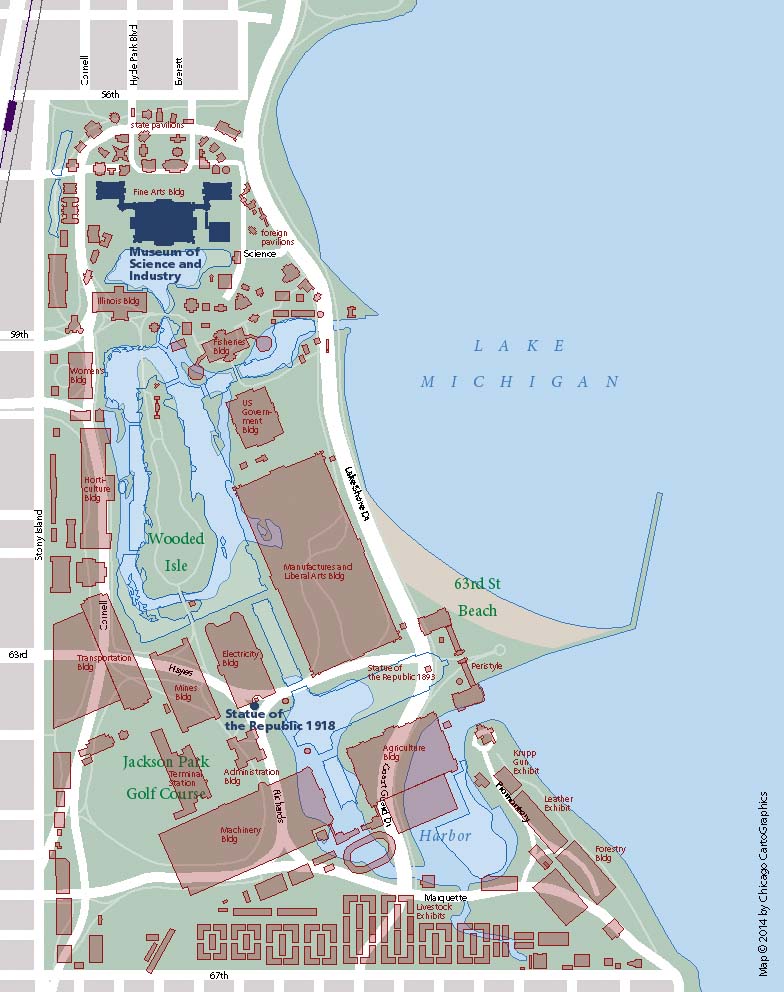The Forgotten Railways of Chicago: The Columbian Intramural Railway
In 1893, the City of Chicago hosted the World's Fair, and paid homage to the 400th anniversary of Christopher Columbus "discovering" the New World of North America. Far more than any involvement the memory of Columbus had, the Exposition was among the most iconic events in Chicago history. After all, one of the stars on Chicago's Municipal Flag commemorates the event.
 |
| A present-day view of Jackson Park overlaid with the buildings of the 1893 Worlds Fair. (2014 Chicago Cartographics Map via Chicago In Maps.) |
Held in the South Shore, Woodlawn, Hyde Park and Jackson Park neighborhoods on Chicago's South Side, one can see evidence of the Exposition even today, as the Museum of Science and Industry currently occupies part of where it was held. The neoclassical architecture of much of the expo led to Chicago being referred to as the "White City" before the nickname "Windy City" took hold. The event was intertwined in success for showcasing the city, but also of a serial killer, expertly portrayed in Devil in the White City by Erik Larson. The expo's impact on architecture and the culture of the City, and indeed the Country as a whole, has not been overstated, but has been covered extensively by many historians greater than myself. (And some worse.)
One part of the Exposition that not a trace of remains today, is the elevated railroad, which over 6 million passengers used to move within the grounds, known as the Columbian Intramural Railway.
 |
| Image: Chicagology |
Built for, and used exclusively by the Exposition guests, it was abandoned immediately upon the end of the expo in 1893, after roughly a year in construction and operation. Despite its relatively long length at nearly three miles of trackage north to south, six miles total, which would be longer that a few Class III railroads, it was deemed not to serve any transit purposes outside of the expo, and did not connect to any other stations, with the exception of a temporary station on the Jackson Park Branch of Chicago's future "L" system. While just a prototype system, and one that lasted only for a year, I would argue that it was far more successful than some of the other lines we have covered around here.
It was both a method of transportation and a prototype electric railway, something that would gain significant popularity, if not profitability, in the decades following the fair. One could draw parallels to it and future amusement park trains and transportation methods, such as the Monorail at Walt Disney World.
 |
| A view of one of the ends of the CIRwy. Each end of the line was a circle, allowing the car to switch directions of travel. |
 |
| Here's a rough trace on our abandoned railroad rights of way map, although I freely admit it is not as accurate as it could be. |
 |
| The Intramural Railway Generator, via Chicagology |
Popular Science in October 1893 paid special attention to the design of the railway, stating, "this road is a double-track elevated structure something over three miles in length, which forms the highway of communication between the different buildings. It is purposely laid out with many an unnecessary curve, to accentuate the conditions of actual travel, and demonstrate the ability of electric traction to do its work satisfactorily under extreme conditions. The trains are made up of a motor car and three trailers, all four cars being arranged to seat passengers, the space occupied by the motorman at the extreme front end of the motor car being no greater than that of the ordinary trolley car. The cars are open, with the seats extending clear across the car body, each pair facing upon the entrance aisles. These aisles are closed by sliding gates, which are connected so that all those on one side of the car may be opened or closed at the same time by the movement of a lever at the end of the car. This construction might be very readily adapted to a closed car, and would seem to be admirably suited to cars having the phenomenally heavy traffic of those on the elevated roads of New York."
 |
| "Bird's-eye view of the World's Columbian Exposition and the intramural tramway, Chicago, Illinois, 1893. Photograph by Kaufmann & Fabry." (Chicago History) |
The cost of the railroad was about $1,000,000 at the time (worth nearly $29 Million today), and while six million rides occurred on the track, it did not come close to recouping this investment, although overall the expo was a huge fiscal success, and the Intramural Railway certainly helped toward that end.
 |
| Image: Bancroft, Hubert Howe, 1893. University of Chicago |
The Book of the Fair also notes a tug of war between an electric and a steam engine. "The 16th of September, the date on which the (sic) Manchester and Liverpool Railway was opened sixty-three years before, was selected as railroad day by the Exposition authorities. Many prominent railroad men from the United States and foreign countries participated in the exercises and recreations, which included a trip on the intramural road, the movable sidewalk, and the historic pioneer train drawn by the John Bull, with a tug of war between an electric and a steam engine, the steam locomotive, though only an old switch engine, easily dragging its competitor along the track. The exercises, which were held in Festival hall, were largely attended, and included the usual feasting and speech-making."



Comments
Post a Comment